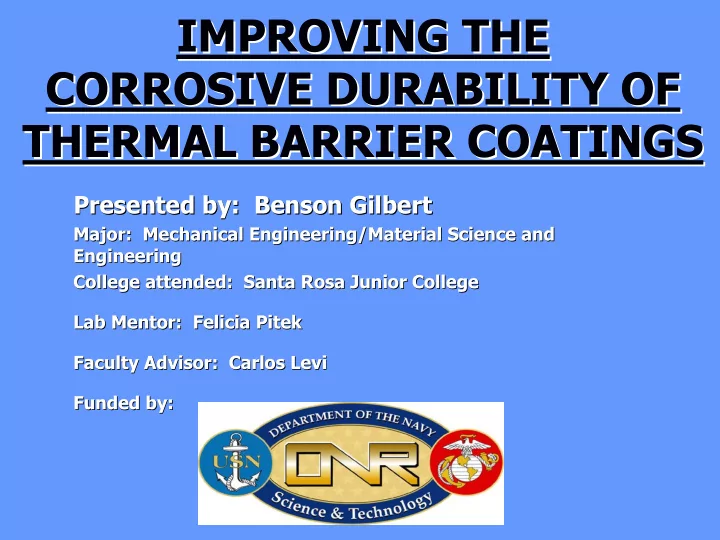

IMPROVING THE IMPROVING THE CORROSIVE DURABILITY OF CORROSIVE DURABILITY OF THERMAL BARRIER COATINGS THERMAL BARRIER COATINGS Presented by: Benson Gilbert Presented by: Benson Gilbert Major: Mechanical Engineering/Material Science and Major: Mechanical Engineering/Material Science and Engineering Engineering College attended: Santa Rosa Junior College College attended: Santa Rosa Junior College Lab Mentor: Felicia Pitek Lab Mentor: Felicia Pitek Faculty Advisor: Carlos Levi Faculty Advisor: Carlos Levi Funded by: Funded by:
Overview of Thermal Barrier Coatings (TBCs) • What are TBCs? • Thermal and corrosion resistant ceramic shields to underlying alloy components • Conventional TBCs are made of yttria stabilized zirconia (7YSZ) • Applications of TBCs • Propulsion • Power generation • Failures of current TBCs • Being corroded by dirty fuels and other contaminates such as V, S, Na---reducing TBC life • The need for improved TBCs
GOAL: Gain understanding of how to make a better TBC 1. Production of 5 different yttria stabilized zirconia (YSZ) Heat Transfer through reverse co-precipitation • Doped with yttrium and/or tantalum 2. Producing Powders • Pyrolization • Grinding solid into powder form 3. Pressing the compositions into pellets 4. Analysis before corrosion testing using • X-Ray Diffraction (XRD) 5. Corrosion Testing • Putting vanadate/sulfate corrodant on pellets • Heat Treatment of pellets 6. Analysis after corrosion testing looking for phase stability using • X-Ray Diffraction (XRD) • Transmission electron microscope (TEM) • Scanning electron microscope (SEM) with electron dispersive spectroscopy (EDS)
Hot Corrosion Testing Device and Setup Corrosion Environment 25-35mg/cm 2 Na 2 SO 4 -30mole%NaVO 3 900 o C in air
Phase Stability of Yttria Stabilized Zirconia (YSZ) cubic (c) crystal fluorite (F) is a structure particular structure Fabrichnaya, 2003 of cubic Temperature ( o C) F e t e tetragonal (t) monoclinic (m) crystal structure crystal structure m+F m+ δ mole fraction YO 1.5 YO YO 1. 1.5 Y 2 O 3 (in t-ZrO 2 ) + V 2 O 5 (melt) = 2YVO 4 + m-ZrO 2
ZrO 2 -YO 1.5 -TaO 2.5 Ternary Phase Diagram Sample Compositions • Sample A (a)---7.6mole% YO 1.5 • Sample D (d)---15.2mole% YO1.5 • Sample B (b)---15.2mole% YO 1.5 + 7.6mole%TaO2.5 • Sample C (c)---22.8mole% YO 1.5 • Sample E (e)---30.0mole% YO1.5 + 7.6mole%TaO2.5
XRD and SEM Analysis of the Microstructure and Phase Changes 7.6YO 1.5 Spalled Area Spalled Area Exposure Time m m YVO 4 2.0YO 1.5 t 200 hrs YVO4 m m YVO 4 t 100 hrs t 0 hrs 2.0YO 1.5 400 µ m 2 µ m 22 26 30 34 38 2 θ (degrees) 15.2YO 1.5 Crystal Product Formation Exposure Time YVO 4 YVO 4 m m c 200 hrs YVO 4 m c m 100 hrs c 0 hrs 10 µ m 22 26 30 34 38 2 θ (degrees)
XRD and SEM Analysis of the Microstructure and Phase Changes 22.8YO 1.5 Representative Surface Exposure Time YVO 4 YVO 4 c 200 hrs m m YVO 4 c 22.8YO 1.5 100 hrs c 0 hrs 22 26 30 34 38 5 µ m 2 θ (degrees) 15.2YO 1.5 + 7.6TaO 2.5 Representative Surface Exposure Time 15.2YO 1.5 + 7.6TaO 2.5 YVO 4 t 200 hrs 5.5Y t 100 hrs 5.7Ta t 0 hrs 22 26 30 34 38 4 µ m 2 θ (degrees)
XRD and SEM Analysis of the Microstructure and Phase Changes 30.0YO 1.5 + 7.6TaO 2.5 Representative Surface Exposure Time c YVO 4 200 hrs 30.0YO 1.5 + 7.6TaO 2.5 c 100 hrs c 0 hrs 22 26 30 34 38 100 µ m 2 θ (degrees)
Summary of Analysis • Hot corrosion tests on all 5 compositions for 200 hours • 7.6YO 1.5 and 15.2YO 1.5 samples • Formation of product YVO 4 after 100 hours • Phase Change from tetragonal to monoclinic after 100 hours • Spalled areas (where product breaks away from sample) found only on 7.6YO 1.5 sample • 22.8YO 1.5 sample • Formation of product YVO 4 after 100 hours • Phase Change (small amounts) from tetragonal to monoclinic after 200 hours • 15.2YO 1.5 + 7.6TaO 2.5 and 30.0YO 1.5 + 7.6TaO 2.5 samples • Small amounts of product YVO 4 formed after 200 hours • Considerably less found on 30.0YO 1.5 +7.6TaO 2.5 than on 15.2YO 1.5 + 7.6TaO 2.5 • No phase change from tetragonal to monoclinic • Best performance among samples
Future Plans • Continue hot corrosion tests on all 5 compositions for up to 500 hours • Conduct analysis on the phase changes and microstructure of the samples after each 100 hours of testing • Comparison of compositions with baseline 7YSZ to determine the effect of increasing yttria content and co-doping with TaO 2.5
Acknowledgements Acknowledgements Lab Mentor: Felicia Pitek Lab Mentor: Felicia Pitek Faculty Advisor: Carlos Levi Faculty Advisor: Carlos Levi Research Funded by: Research Funded by: Internship Funded by: Internship Funded by:
Recommend
More recommend